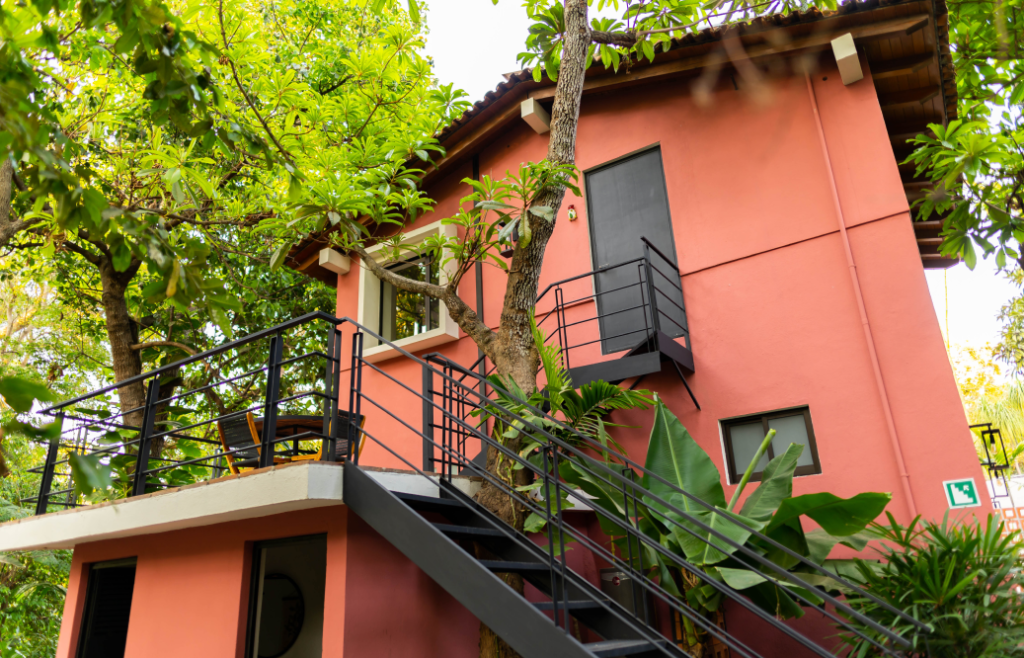
The municipality of Comala was founded in 1857; we don’t know much about La Paranera from around that time, but we do know some details from 1930 onwards.
Back then, this land was one of several open-field fruit orchards, this one in particular became known among the comaltecos (Comala natives) because there was a spring. Hence, one of the names for this place was los chorritos (which translates to the little streams). We don't know if the diminutive came from affection –in Mexico we use diminutives for things we care for– or because the water flowed slowly.What we do know is that people used to pass by with jugs to fill them with spring water, which they would then take back home.
The spring gave a second name to this place, as around the spring, a grass called ‘parán’ grew, which is where the name ‘paranera’ comes from. at La Paraneraon the contrary, it was the daily life of that time that baptized us.
By the mid-20th century, the comalteco Samuel Fuentes Salazar, and his wife Engracia Gómez Guerrero from Tolimán, Jalisco, became the custodians of this land, bringing more life to the orchard by planting some of the most productive species in the region: mamey, guamúchil, coconut palm, guava, mango, soursop, and coffee, primarily. Don Samuel enjoyed spending his afternoons maintaining the fruit trees, as nature was always one of the spaces he loved the most.
Seeing the orchards today makes us think that it has always been a place of natural beauty. Walking on the leaf litter, appreciating the trees from the roots, contemplating their bark, and reaching the tops with our gaze gives us perspective, the kind we often need. When the foliage up there is abundant, the wind gives us a spectacle for the eyes and ears. Later in the year, when the leaves are gone, those treetops take on flavor by becoming delicious fruits... who wouldn't find beauty in such a place?
As if that weren't enough, listening to the birds converse from one tree to another regardless of the distance will always be amazing; even more so if they let themselves be seen among the leaves, which happens often. Parakeets, owls, and woodpeckers are some of the species you are sure to find walking around here.
But not everything happens up there. It is a joy to see the squirrels running around, the iguanas sunbathing, and finding burrows here and there; it seems like a minefield of life! We consider ourselves very fortunate to have the opportunity to get to know the fauna of our region so closely.
With the aim of preserving biodiversity in this region, on June 23, 1988, a decree was issued declaring 'Las Huertas de Comala' as a protected natural reserve, because –as we’ve mentioned before– its climate is home to a variety of flora and fauna species that constitute a truly unique ecosystem in our region. We feel fortunate to be part of the 412 acres of the reserve, also considered the lung of the northern zone of the state of Colima.
Towards the end of the century, La Paranera was inherited by the eldest daughter of the Fuentes Gómez family, Mrs. Nely, who, motivated by the beauty of the space, along with her husband, built a house to enjoy weekends with their 3 children.
Some years later, they decided to turn that space into their permanent residence, for which they asked architect Juan Castillo to design a proposal that would adapt to the environment and –above all– comply with the guidelines established for building in the middle of the reserve.
The house was built in the center of the property and initially had a central courtyard, a couple of terraces, a living room, a kitchen, four bedrooms, and a swimming pool. The design of the property carries Mrs. Nely's talent, who has always enjoyed the beauty of spaces and is fond of attention to detail. These have made the house something special ever since. The fountain, for example, has some ceramic tiles with spring flowers, an icon for the colimotes (Colima natives), because around February and March, the city gets dressed in bright yellow with the heaps of spring flowers.
As you can see, the orchard received much love during all this time. The family took care of the place, always seeking to see the fruits of those trees planted by the previous generation. With stones, they formed a path that remains to this day, and that runs through La Paranera in a circuit, passing by the spring that –it is worth noting– today no longer sees water flowing as it did back in the early 1900s.
The family continued to grow, and each of the children left the maternal home, the parents became grandparents, and eventually –after 15 years of living in La Paranera– the Orozco Fuentes family decided to move from there to live in a smaller and less demanding house, as maintaining the orchard became a very heavy task for two.
This is how the house at La Paranera became inhabited.
Little by little, months began to pass. Nature grew immeasurably; this tropical climate, life multiplies rapidly. On reaching a year of abandonment, the Orozco Fuentes siblings returned to visit the property.
With sadness, Jesus, Nely, and Juan Carlos realized that the house that was once their home would soon disappear among branches and roots, after having given them so much. It was at that moment when they began to envision at La Paranera as a hospitality project. They wanted to attract travelers to live the endearing experience they enjoyed so much, sleeping surrounded by old trees in the middle of a natural reserve.
The project sounded amazing, but also quite complex. By this time, each of them had other occupations and responsibilities, so finding a way would mean a significant challenge in their lives.
Still, they went ahead, as the affection they have for this property has always been great and has only grown over time. After all, to this day, four generations have enjoyed countless afternoons at the gardens.
The house had to be turned into a hotel, what a challenge! An environmental impact assessment was elaborated to comply with the requirements of preserving the habitat and impacting it as little as possible. During the renovation by architect Matia Di Frenna, two more rooms were built, some spaces were optimized, and La Paranera Hotel & Relax was given an identity by graphic designer Joel Rojas. Among the modifications proposed by the architect are the brick headboards, an icon with which we identify, and that we transferred conceptually to the headboards of the bedrooms in our second property, Casa Paranera, which we will tell you more about in another post.
With great joy, we opened our doors in January 2021, hand in hand with our beloved restaurant Cuaxiote, as we could not have created a home without a heart, the kitchen.
Since the opening, our history has diversified into hundreds of moments in the lives of our guests, our diners, and of all those who pay us a visit. We hope you enjoy your stay, walk along the path that runs through our orchard, and that La Paranera takes up a space in your memories and in your heart.


